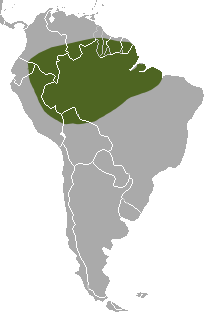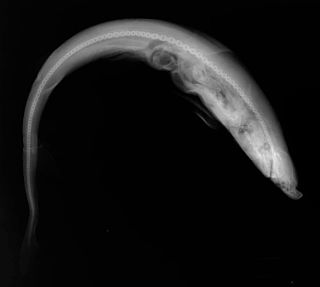
Weasels are mammals of the genus Mustela of the family Mustelidae. The genus Mustela includes the least weasels, polecats, stoats, ferrets, and European mink. Members of this genus are small, active predators, with long and slender bodies and short legs. The family Mustelidae, or mustelids, is often referred to as the "weasel family". In the UK, the term "weasel" usually refers to the smallest species, the least weasel (M. nivalis), the smallest carnivoran species.

Carcharhiniformes, the ground sharks, are the largest order of sharks, with over 270 species. They include a number of common types, such as catsharks, swellsharks, and the sandbar shark.

Carpet sharks are sharks classified in the order Orectolobiformes. Sometimes the common name "carpet shark" is used interchangeably with "wobbegong", which is the common name of sharks in the family Orectolobidae. Carpet sharks have five gill slits, two spineless dorsal fins, and a small mouth that does not extend past the eyes. Many species have barbels.

The Amazon weasel, also known as the tropical weasel, is a species of weasel native to South America. It was first identified from a museum specimen mislabelled as coming from Africa, hence the scientific name.

A grison is any mustelid in the genus Galictis. Native to Central and South America, the genus contains two extant species: the greater grison, which is found widely in South America, through Central America to southern Mexico; and the lesser grison, which is restricted to the southern half of South America.

Mustelus, also known as the smooth-hounds, is a genus of sharks in the family Triakidae. The name of the genus comes from the Latin word mustela, meaning weasel. It should not be confused with the genus name Mustela, which is used for weasels.
Hemipristis is a genus of weasel sharks, family Hemigaleidae. It contains one extant species, the snaggletooth shark and several extinct species.

The short-tail nurse shark is a nurse shark in the family Ginglymostomatidae, the only member of the genus Pseudoginglymostoma. It is found in the tropical western Indian Ocean between latitudes 0° and 27° S, and reaches a length of 75 cm.
The weasel sharks are a family, the Hemigaleidae, of ground sharks found from the eastern Atlantic Ocean to the continental Indo-Pacific. They are found in shallow coastal waters to a depth of 100 m (330 ft).

The hooktooth shark, is a weasel shark of the family Hemigaleidae, the only extant member of the genus Chaenogaleus, but there is an extinct species, Chaenogaleus affinis. The hooktooth shark is found in the tropical Indo-West Pacific oceans between latitudes 30° N and 10° S, including the Persian Gulf, Pakistan, India, Sri Lanka, Singapore, Thailand, Viet Nam, China, Taiwan, and Java and Sulawesi in Indonesia, from the surface to a depth of 59 meters. It can reach a length of 1 meter. It is considered a vulnerable species.

The Australian weasel shark is an uncommon species of ground shark in the family Hemigaleidae. It inhabits shallow waters off northern Australia to a depth of 170 m (560 ft); smaller sharks frequent sand and seagrass habitat and shift to coral reefs as they grow older. A slim, drab species reaching a length of 1.1 m (3.6 ft), it has sickle-shaped fins with dark tips on the second dorsal fin and caudal fin upper lobe. Its upper teeth are broad with strong serrations only on the trailing edge. The lateral line along each side is prominent and exhibits a downward curve below the second dorsal fin.

The sicklefin weasel shark is an uncommon species of ground shark in the family Hemigaleidae. It is native to southern India, southern China, and parts of Southeast Asia, living in shallow waters down to a depth of 170 m (560 ft). This lightly built shark is characterized by its very short mouth, broad upper teeth with serrations only on the trailing edge, and strongly sickle-shaped fins with obvious white tips on the two dorsal fins. It is light grey or bronze in colour, often with small white blotches on its sides; it reaches a maximum known length of 1.1 m (3.6 ft).

The whitetip weasel shark(Paragaleus leucolomatus) is a weasel shark of the family Hemigaleidae. Only one specimen, caught off Kosi Bay, South Africa, has been caught. That specimen was 96 cm long. In 2020, a fuzzy image believed to be this shark was obtained on the show Extinct or Alive.

The Atlantic weasel shark is a weasel shark of the family Hemigaleidae, found in the eastern Atlantic Ocean. Also known as the little tiger shark, it is the only species of the genus Paragaleus to have been recorded off the western coast of Africa. It is one of four species of small sharks within the carcharhinoid genus Paragaleus, including Paragaleus leucolomatus, Paragaleus tengi, and Paragaleus randalli. It also one of eight species within the weasel shark family, Hemigaleidae. It is currently considered by the International Union for Conservation of Nature (IUCN) as Endangered.

The slender weasel shark, Paragaleus randalli, is a weasel shark of the family Hemigaleidae. It is found in the western Indian Ocean, off Bahrain. It can grow up to a length of 48 cm.

The straight-tooth weasel shark, Paragaleus tengi, is a weasel shark of the family Hemigaleidae, found in the tropical western Pacific Ocean. It can reach a length of 88 cm.

Galidictis is a genus in the subfamily Galidiinae of the family Eupleridae: a group of carnivorans that are endemic to Madagascar.

Paragaleus is a genus of weasel shark in the family Hemigaleidae. This genus has a rounded or slightly pointed snout, short gill slits, and a broadly arched mouth. The upper teeth have long cusps, and no toothless spaces occur at the jaw midlines. The dorsal and pelvic fins and the lower caudal lobe are not falchate in shape. Known fossil species include P. pulchellus and P. antunesi.

The Australian grey smooth-hound or also known as the grey gummy shark is a species of houndshark classified under the large family Triakidae. It is one of the twenty-eight species belonging to the genus Mustelus, which are often small in length. While members of the genus Mustelus may be found globally in tropical and temperate waters, the grey gummy shark in particular is native to the Pacific Ocean and Indian Ocean waters surrounding Australia and is particularly widespread in deep coastal waters. The grey gummy shark is known to be a viviparous species and gives birth to live young. With little data available, it is regarded to have a relatively stable population and possesses little threat to humans.

















